Connection of wires with crimping sleeves
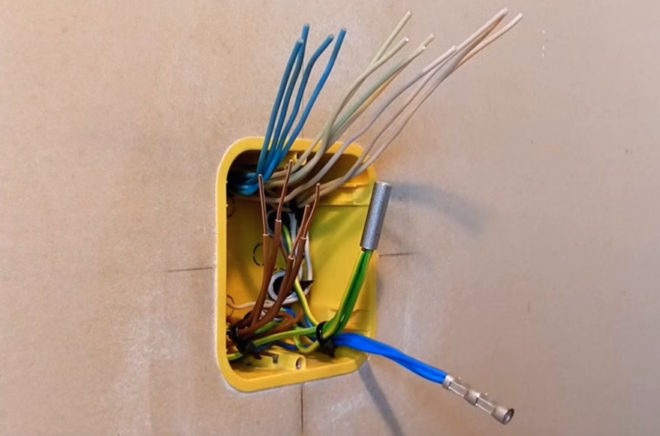
There are a lot of ways to connect wires - from the old grandfather's twisting to the most modern self-clamping terminal blocks. But none of them are perfect, each method has its own advantages and disadvantages. In some case, it is enough to connect the wires in the terminal block, sometimes welding or soldering will be needed. But there are times when crimping the wires is the best option, let's talk about it in more detail.
Content
What is the essence of the method?
Crimping is a method of connecting wires using special sleeves. Outwardly, they look like ordinary tubes and serve as a connecting mechanism.

The conductors of the wires to be connected are inserted into the tube from two opposite ends, crimped with press tongs and as a result, a strong and reliable electrical assembly is obtained. The tube is compressed in two or three places, depending on its length and cross-section of the switched conductors. The connected cores and the sleeve undergo joint deformation. At this moment, the conductive surfaces of the conductors are compressed and squeezed by the tube. Due to this, the conductors are mutually interlocked, which gives a reliable electrical contact.
Then the junction is insulated.
Most often, this method is used in situations where it is not possible to apply another type of connection. For example, welding requires the presence of electricity so that you can connect the welding machine. When working in a small junction box, it is inconvenient to locate the bolt connection, nut clamp or terminal block. And with a soldering iron, reaching for the ceiling to the junction box is also not very convenient. In such cases, crimping the wires with the help of sleeves helps out.
The crimping method is most in demand:
- if it is necessary to connect wires in power lines with high current load;
- for switching stranded conductors;
- if it is necessary to connect wires of large cross-section.
Advantages and disadvantages
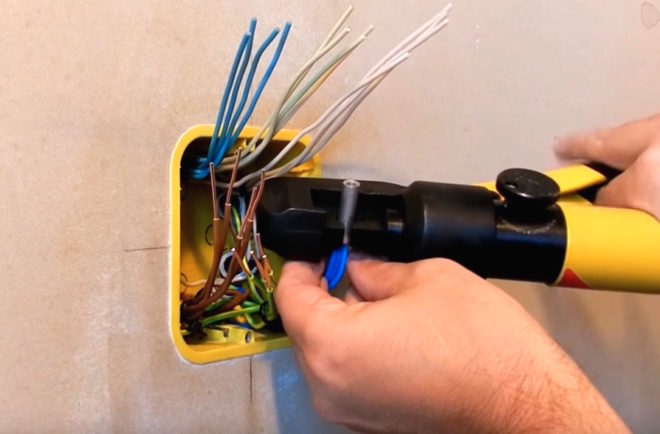
There are many positive aspects in crimping:
- The tool with which such a connection is made is manual; it does not need electricity to work. In the case when you have to work in a room where there is no voltage, crimping is the only high-quality connection method.
- With the help of crimping tubes, conductors made of different metals can be connected, which is a solution to the eternal problem of switching copper and aluminum conductors in one electrical unit.
- If welding requires a specialist who is able to perform welding, and when soldering it is necessary to be able to use a soldering iron, then everyone can do crimping, it is enough to try the press tongs in action only once.
- With the help of a special crimping tool, it is possible to perform commutation in any, even confined spaces. It is especially convenient when connecting wires in a socket or box.
- Crimping with press tongs and sleeves allows you to shorten the connected sections of wires to a minimum.
- The mechanical force creates the most durable contact connection.
- As a result of crimping, a one-piece connection is obtained, which can withstand high physical stress at breaking.
- Installation speed is minimal, connection quality is maximal.
- This contact does not need any maintenance.
The non-detachable type of crimping is in some way a disadvantage, that is, if necessary, you cannot untwist the connection and replace one of the conductors.The sleeve can only be cut out.
Tools and materials
For work, you need manual (or mechanical) press tongs. They crimp sleeve with conductors up to 120 mm2... For cores of a larger cross-section, a press is required, which is driven by a hydraulic drive.
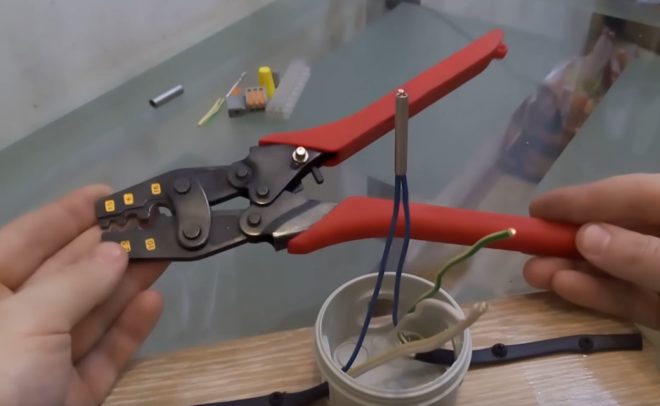
There are pliers with dies for different sections and with adjustable punches. A very convenient tool in the sense that it is not necessary to constantly reinstall it to other dimensions, just the punch screw or the die is rotated to the desired section.
When working with aluminum wires, you will need a special quartz-vaseline paste, which removes the oxide film on the veins and prevents it from reappearing.
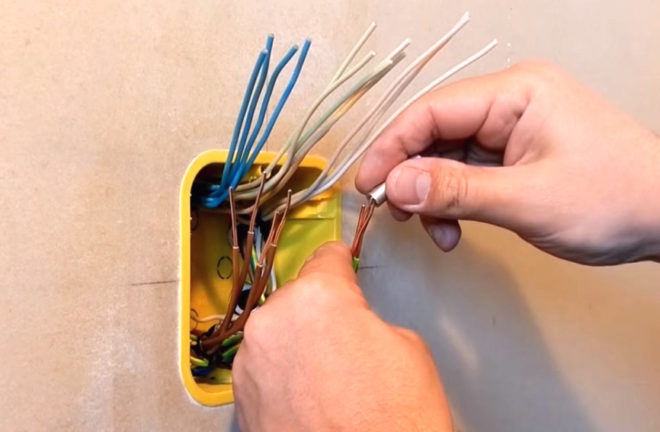
Copper conductors do not need such processing, but nevertheless, to reduce friction, it is advisable to lubricate them with ordinary technical vaseline. Strains can be damaged during deformation and lubrication minimizes this risk.
Sleeve types
It is very important to choose the right sleeves for crimping wires.
By material of execution
The copper cable or wire, respectively, should be crimped with copper sleeves. They are of two types and have the following abbreviation:
- GM - copper sleeves. They are made purely of copper, do not have any coating or processing, in appearance they look like ordinary pieces of copper tubes.
- GML - tinned copper sleeves. They undergo a tinning procedure, that is, their surface is treated with a special tin-bismuth layer. This is done in order to prevent oxidation and corrosion processes. It is also known from school physics lessons that copper, like any other metal, oxidizes. Tinning prevents this process, the crimped wires will not chemically react with the tinned sleeve.

I would like to give one useful advice. Do not listen if suddenly someone from experienced electricians will prove to you that with the help of GML sleeves it is possible to crimp aluminum wires, since the tin layer will not allow direct contact between aluminum and copper. This is not true, because during pressing, the surface layer of the tube is deformed and a corrosion process is still inevitable.
To connect aluminum wires, they use products made of the same metal, they are designated GA (aluminum sleeve).
There are also combined sleeves, they are designated GAM (aluminum-copper sleeve), in everyday life many call them aluminum-copper. This option is used when you need to butt-joint wires from different metals. The sleeve is a tube of two parts; at the junction of dissimilar metals, the connection is made by friction welding. Everything here is extremely simple and clear - it is necessary to insert copper conductors into the part of the tube made of copper, and an aluminum conductor into the aluminum part.
And the most modern version with the designation GSI (insulated connecting sleeves). They are based on ordinary tinned tubes, only they are covered with polyvinyl chloride insulation on top. They crimp copper wires. During crimping, the insulating layer is not removed, the pliers are put on over it, and compression is performed. Such sleeves greatly simplify the work of the electrician, since the crimped electrical assembly does not require any more additional measures to isolate it.
By size
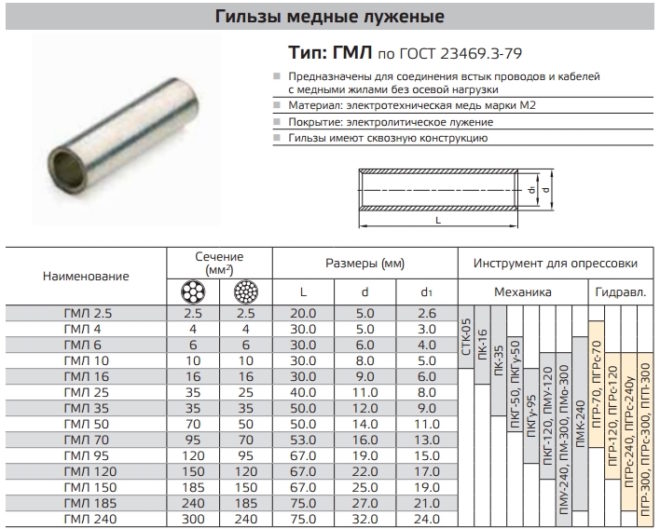
After the letter designations, a number is written on the sleeve. What does it mean? This is the cross-section of the conductor for which this product is designed. For example, tinned copper sleeves are produced for wires with a cross section of 2.5 to 300 mm2... Accordingly, with an increase in the cross-section of the conductor, the sleeve itself (diameter and length) also has large dimensions. For combined products, two numbers are written through a fraction, one indicates the cross-section of a copper conductor, the second - an aluminum one.
By design
The sleeves also differ in design. They can be hollow, that is, inside they are through bare tubes.And they come with a partition in the middle, which allows you to adjust the depth of entry of the conductors, that is, the ends of both connected cores will enter the sleeve at the same length. Combined sleeves are produced with partitions, which are used when switching conductors into a joint.
Fundamental rules
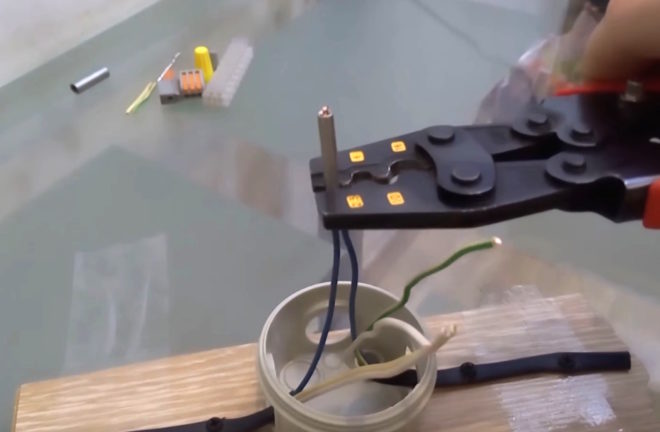
Crimping the wires is not particularly difficult. You just need to know and take into account several important rules:
- The metals from which the sleeve and the conductors to be connected are made must necessarily correspond to each other.
- Many electricians shorten the factory sleeves and simply saw off the excess part with a hacksaw for metal. This is undesirable, since the reliability of the contact connection is reduced.
- Crimping of wires with sleeves should be done only with the help of a special tool - press tongs. You do not need to use a hammer or pliers, as it is possible to damage both the sleeve and the conductor being crimped.
- The sleeve should be selected with such an inner diameter that it is as close as possible to the diameter of the crimped wire.
It is a very common mistake when trying to reduce the cross-section of the conductor in order to adjust it to the size of the tube. For example, if there is a sleeve with a smaller diameter, some people want to cheat and remove a few veins from the stranded wire. Never do this, because the resistance will increase, the bandwidth will decrease, which will lead to heating and destruction of the contact connection.
Technology
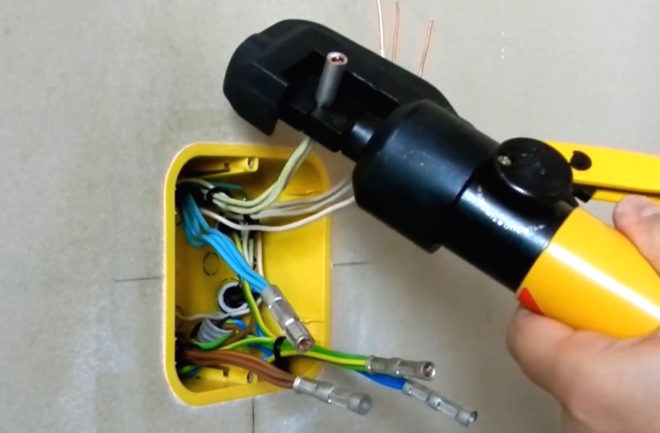
- On the wires to be connected, remove the insulating layer by 2-3 cm.
- Now, using fine-grained sandpaper, sand the bare areas to a metallic sheen.
- If the conductors are aluminum, apply a quartz-vaseline paste on them, if copper, then technical vaseline.
- For one-sided crimping, arrange the wires parallel to each other and slide a sleeve over them. For double-sided, insert the stripped cores into the tube from opposite ends to the joint.
- Crimp the joint with press pliers, wipe with a cloth soaked in gasoline or solvent, insulate with electrical tape, heat-shrinkable tubing or varnish.
Disconnecting the wires in the junction box using crimping is shown in detail in this video:
As you can see, there is nothing complicated in crimping, and you get a reliable and high-quality connection. If you need to perform a similar work of a one-time nature, you can ask someone for the press tongs or rent them. In the case when you often encounter electrical work, purchase a tool, it is not too expensive.




